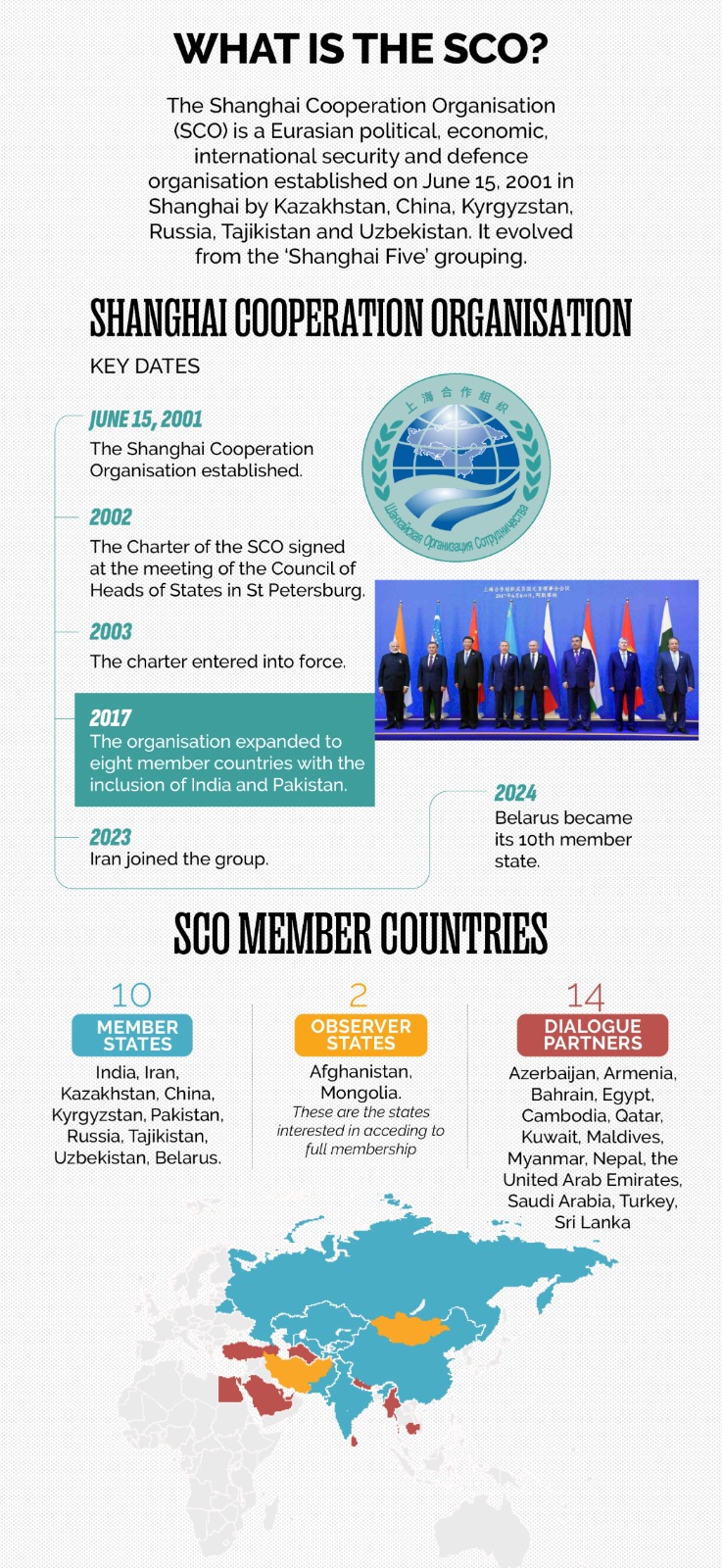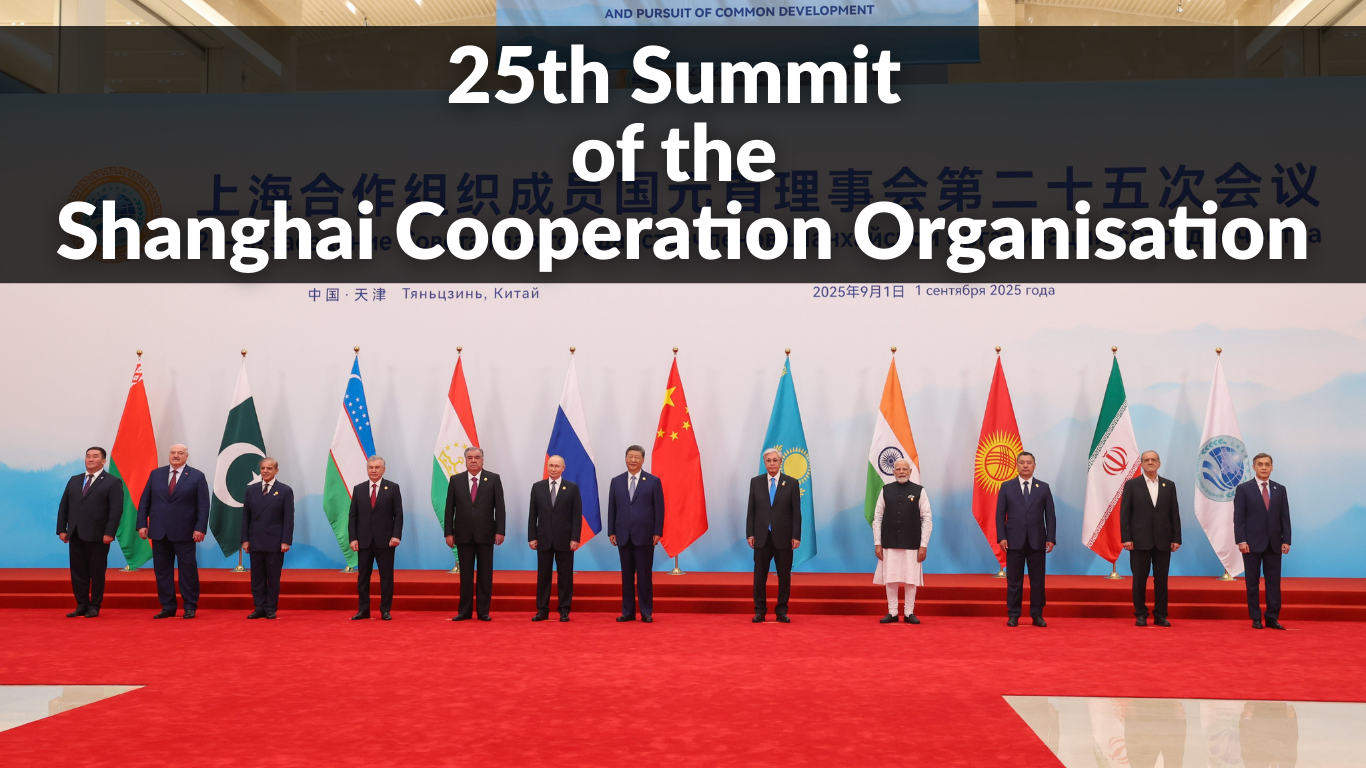Context:
The 25th Summit of the Shanghai Cooperation Organisation (SCO) was held in Tianjin, China, in 2025, bringing together leaders of ten member states—China, Russia, India, Pakistan, Iran, Belarus, Kazakhstan, Kyrgyzstan, Tajikistan, and Uzbekistan.
The summit came at a critical juncture: global politics is increasingly multipolar, Eurasia is becoming the new frontline of great power competition, and institutions like the SCO are being tested on whether they can go beyond symbolic declarations to deliver concrete cooperation.
For India, participation was significant. It marked Prime Minister Narendra Modi’s first visit to China in seven years and his first bilateral meeting with Chinese President Xi Jinping since the 2020 border clashes. Against this backdrop, the summit was as much about geopolitics as it was about institutional cooperation.
Major Outcomes of the 2025 Summit
1. Counter-Terrorism and Security Cooperation
The Tianjin Declaration adopted at the summit renewed commitment to combat terrorism, extremism, and separatism—the so-called “three evils.”
-
-
-
-
Members agreed to intensify coordination through RATS, including more joint exercises and intelligence sharing.
-
Cybersecurity emerged as a priority, with discussions on creating a regional mechanism against cyber terrorism and online radicalization.
-
India reiterated its concern over “double standards” in counter-terrorism, indirectly targeting Pakistan for cross-border terrorism and those providing political cover to such activities.
-
-
-
2. Connectivity and Trade
-
-
-
-
China pushed for stronger alignment with the Belt and Road Initiative (BRI). While Russia and Central Asian states supported it, India stood firm in its opposition, citing violations of sovereignty in the China-Pakistan Economic Corridor (CPEC).
-
Iran promoted the Chabahar Port and its International North-South Transport Corridor (INSTC) links, presenting it as a neutral alternative to BRI.
-
A working group on digital economy, e-commerce, and fintech cooperation was established, marking a step towards reducing dollar dependence in trade.
-
Agreement was reached to promote local currency settlements among member states.
-
-
-
3. Energy and Climate Change
Energy-rich members like Russia, Kazakhstan, and Iran stressed the need for stable energy flows to South Asia and beyond.
-
-
-
-
Proposals were made for cross-border pipelines, renewables cooperation, and regional electricity grids.
-
India emphasized clean energy technologies and affordable financing for the energy transition.
-
The SCO adopted a Joint Climate Action Plan, focusing on desertification control, water security, and renewable energy expansion.
-
-
-
4. Institutional Expansion and Reform
-
-
-
-
Belarus was admitted as the newest full member, expanding the SCO to ten states.
-
Observer states like Mongolia, Afghanistan, and Turkey expressed interest in deeper involvement.
-
Discussions were held on institutional reforms, with India pushing for greater transparency, consensus-based decision-making, and reduced dominance of any single member.
-
-
-

India’s Role at Tianjin
India approached the summit with calibrated pragmatism:
1. Terrorism as the Core Issue:
o PM Modi strongly reiterated that terrorism remains the greatest threat to peace and prosperity in the region.
o India used the SCO to underline Pakistan’s duplicity while avoiding direct confrontation.
2. Connectivity with Caution:
o India stressed the importance of physical and digital connectivity, but with the condition that it must respect sovereignty and territorial integrity.
o By promoting Chabahar and INSTC, India presented an alternative connectivity vision, reducing overdependence on Chinese projects.
3. Balancing Great Powers:
o Despite its strained ties with both China (border tensions) and Russia (Moscow’s closeness with Beijing), India chose active participation to avoid being isolated from Eurasian geopolitics.
o This reflects India’s broader strategy of multi-alignment, engaging with different blocs without fully subscribing to any.
4. Economic and Energy Interests:
o India highlighted its need for access to Central Asian energy resources.
o Proposed closer cooperation in pharmaceuticals, IT, and digital technologies, areas where India has comparative advantage.
About Shanghai Cooperation Organisation:
|
Why the SCO Matters for India
1. Strategic Access to Central Asia:
o India lacks direct land connectivity with Central Asia due to Pakistan’s obstruction. The SCO provides a multilateral platform to engage the region.
2. Countering China and Pakistan:
o India cannot afford to vacate Eurasia, leaving the space open for China-Pakistan influence. The SCO keeps India in the room where strategic decisions are being shaped.
3. Energy Security:
o With growing energy needs, India sees the SCO as a mechanism to secure stable energy ties with Russia, Kazakhstan, and Iran.
4. Platform for Narrative Building:
o India uses the SCO to highlight terrorism, sovereignty, and transparency, aligning with its global image as a responsible stakeholder.
5. Bridge in Multipolar Politics:
o India’s presence ensures it remains engaged with both Russia and China, while balancing its ties with the US and Europe through other groupings like the Quad and G20.
Challenges and Limitations
-
-
-
China’s Dominance: The SCO is heavily tilted towards China, both financially and institutionally.
-
India-Pakistan Rivalry: Bilateral disputes often spill into the organization, limiting its effectiveness.
-
Russia-China Convergence: With Moscow leaning closer to Beijing due to Western sanctions, India faces a narrowing space to maneuver.
-
Lack of Binding Commitments: SCO declarations often remain non-binding, reducing their practical impact.
-
Contradictory Interests: While members agree on combating terrorism in principle, definitions vary widely. For example, groups India sees as terrorist outfits are viewed differently in Pakistan or China.
-
-
Wider Geopolitical Implications
-
-
-
For Eurasia: The SCO is becoming the principal platform shaping Eurasian geopolitics, competing with Western-led institutions like NATO and the EU.
-
For Global Governance: It reflects the trend of non-Western groupings asserting influence, with China and Russia projecting the SCO as a counterweight to Western dominance.
-
For India: Balancing between SCO (China-Russia led) and Quad/IBSA (democratic, Indo-Pacific focused) highlights the complexity of India’s strategic diplomacy.
-
For Global Economy: With initiatives like local currency settlements and energy corridors, the SCO is slowly pushing towards de-dollarization in Eurasian trade.
-
-
Conclusion
The Tianjin SCO Summit 2025 reinforced the relevance of the organization as a Eurasian platform, but also exposed its contradictions. For India, participation is not about endorsing China’s vision but about protecting its interests, keeping its strategic footprint in Eurasia, and pushing back against terrorism and unilateral connectivity projects.
The challenge ahead for India is to maintain a fine balance: staying engaged without being overshadowed, using the SCO as a stage for narrative-building while simultaneously deepening other partnerships in the Indo-Pacific and beyond. In short, the SCO for India is less a choice and more a necessity—one that secures its place in the evolving multipolar world order.
|
UPSC/ PSC Main Question: Discuss the role of the SCO in combating terrorism and ensuring regional security. In this context, evaluate India’s attempts to shape the counter-terrorism agenda of the grouping. |







